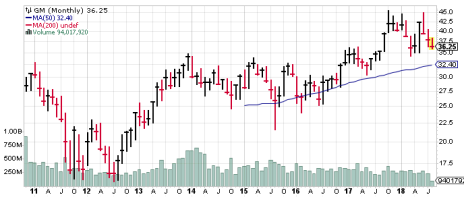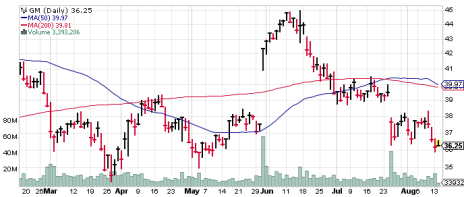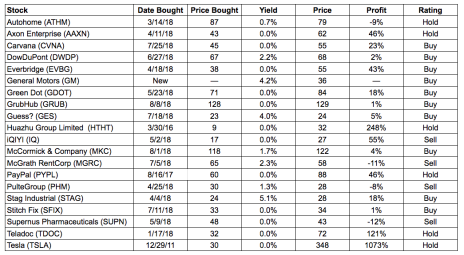The market’s main trends remain up, and thus I remain bullish. But there are some serious crosscurrents out there making investing a bit more challenging.
Cabot Stock of the Week 210
[premium_html_toc post_id="156074"]
The market’s main trend remains up and I continue to recommend a diversified portfolio of stocks that help meet your investment goals, stocks that are chosen using proven investing systems. Generally, these proven systems are the ones used by the various Cabot analysts, but today I want to write about one of my own stock selection systems. As we all know, the goal of investing in stocks is to buy low and sell high.
For value investors, that can mean buying when values are low and selling when values are rational, and for momentum investors that can mean buying when a stock is strong and high and selling even higher. Of course, either way, the goal is to sell higher than you buy. So one of my techniques is to look at the bar charts of stocks from different perspectives: a long-term perspective where every month is a bar, a mid-term perspective where every week is a bar, and a short-term perspective where every day is a bar. (I almost never look at intra-day charts.) Ideally, you want to find a stock where all three charts give the same message. If you’re hunting strength, you want all three perspectives to show strength. And if you’re hunting value, you want all three perspectives to show a chart that has little chance of going lower.
Well, that’s what I see with GM today, a very well known company whose stock yields 4.2%. The stock was originally recommended by Chloe Lutts Jensen three years ago for Cabot Dividend Investor, and her readers are now looking at a total return (capital appreciation plus dividends) of 22%. Normally, I’d have Chloe take it from here, but given that she’s traveling to Salem for the Cabot Wealth Summit (which starts tomorrow), today you get more of my thinking.
General Motors (GM)
A Story of Three Charts
Everyone knows GM. They make cars and trucks. While technically, the current company was born in 2009—reconstituted in the wake of the Great Recession and the Great Bailout and Chapter 11 reorganization—GM is actually more than a century old. And that age shows. GM is no longer growing. And everybody knows that.
In fact, I’d venture that there are very few secrets at all about GM. It’s the model of an old-school bureaucracy where committees make the decisions and nobody issues surprising tweets.
Thus, to as great a degree as any stock in the market, I believe that in the case of GM, everybody who has an interest in the stock knows everything they want to know about GM, from the projections of sales of pickup trucks and cars and crossovers to the projected sales in China to the expectations of progress with autonomous driving to expected costs of steel and aluminum and gasoline to the projections of currency exchange rates and even the potential changes in Federal laws that govern fuel economy and pollution levels and (the fear du jour) tariffs.
All that knowledge is reflected in the chart—and thus the chart knows all.
So here’s the monthly chart of GM, showing buyable bottoms in 2011, 2012, 2014, 2015, 2016, 2017 and 2018—and also showing that it’s possible the stock will come down to below 33.
Here’s the weekly chart, showing more clearly the bottoms in July 2016, May 2017 and March 2018. This chart also says that the stock could pull back below 33.
And here’s the daily chart, which shows the late July plunge on a disappointing earnings report and the recent attempts to find a bottom above the levels set in March and May.
When I add it all up, my conclusion is that the odds are very good that there’s a low between here and just under 33—somewhere in the near future. From today’s level, there’s the potential for a gain of 24% if the stock simply climbs back to its June high of 45. Of course, the stock may drop further first, so truly risk-averse investors may want to wait and try to get a price under 33. But I’ll keep it simple as always and accept tomorrow’s average price.
And then I’ll sit back and enjoy those fat dividend payments and what I believe will likely be solid capital gains in the months ahead.
General Motors (GM)
300 Renaissance Center
Detroit, MI 48265
United States
313-667-1500
http://www.gm.com
CURRENT RECOMMENDATIONS
With the addition of GM, the portfolio grows once again to 20 stocks, which is my limit. So once again, I survey the group to see if there are any stocks that deserve to be sold—and the answer this time is four! iQIYI (IQ) has made half our profit disappear, so that’s a sell. McGrath RentCorp (MGRC) shows a weakening chart and growing loss, with the potential to get even larger. Crista is now selling PulteGroup (PHM), because of estimates of slowing growth. And Supernus (SUPN) has simply lost all positive momentum. As for the rest of the portfolio, there are still plenty of bright spots, and still some stocks hitting new highs, so the long-term plan remains unchanged. Remain fully diversified, and stick to proven investing systems.
Autohome (ATHM), originally recommended by Paul Goodwin of Cabot Emerging Markets Investor, released a fine second-quarter report last week, but the stock is down. Here’s what Paul wrote: “Autohome released what looked like a solid second quarter report, with revenues (up 22%) and earnings (up 32%) both topping expectations, and the firm expects similar growth in Q3. The stock, though, is telling a different story, first with four straight days of big-volume selling last week, and then yesterday’s plunge to its 200-day line following earnings. We will hold on as long as we can, but a close below the 200-day moving average will likely trigger a sell.” Well, since then the stock has fallen below its 200-day moving average, but to me it looks like the selling pressure is ending (amid a climate of great worry about trade) and thus I optimistically expect a bounce soon. In retrospect, I wish I had followed the guideline that suggests selling when half of your profit disappears. If so, we could have sold nearer 103. But today, I’ll hold and look for a bounce. HOLD.
Axon Enterprise (AAXN), originally recommended by Mike Cintolo of Cabot Growth Investor, reported second-quarter earnings after the market close last Tuesday, and the results were good; revenues grew 25% from the year before to $99 million (beating estimates of $96 million), while earnings soared 100% to $0.18 per share, beating analysts’ estimates of $0.09. Nevertheless, the stock sold off the next day, finding a bottom at 60, and it’s been trading calmly there since. Short term, it’s likely the stock will take more time to regain its strength, so I’ll downgrade it to hold now, but long term, I remain bullish on the stock. HOLD.
Carvana (CVNA), originally recommended by Mike Cintolo of Cabot Growth Investor, remains one of the strongest stocks in the market, not least because the market loved the firm’s recent earnings report. In the latest issue of Cabot Top Ten Trader, which also covers the occasionally, Mike wrote, “There aren’t many companies that are trying to revolutionize a $764 billion market, but that’s what Carvana is doing. The firm’s online used car sales process is proving to be a big hit, with customers able to search a massive inventory (11,000-plus automobiles) with 360-degree interior and exterior ‘tours,’ guarantees that the car has never been in a reported accident, and real-time trade-in and financing offers for customers. In many places, delivery can occur the next day, and customers have a seven-day test drive period in case they want to renege on the purchase. And, of course, the prices are generally better, with around $1,000 of savings compared to what you’d get at a dealer. As the firm has expanded its infrastructure (including distribution, car acquisitions and the like), it’s been rapidly expanding—it operated in 21 markets at year-end 2016, 44 at the end of last year and 65 at the end of June, on its way to 80 or so by the end of this year. And these markets have followed a similar, rapid growth trajectory, leading to the triple-digit revenue, car sales and online visitor growth in recent quarters. Plus, while the bottom line is still in the red, the top brass is making solid progress there, too. In Q2, gross profit per car sold rose to $2,173 (up from $1,539 at year-end), while the EBITDA loss was 8.8% of revenue (better than the 16.9% at year-end). Long-term, the sky’s the limit given the size of the industry and Carvana’s attractive offerings.” Try to buy on dips. BUY.
DowDuPont (DWDP), originally recommended by Crista Huff in Cabot Undervalued Stocks Advisor for her Growth & Income Portfolio, is the result of the September 2017 merger of two American industrial giants, but management intends to break it up into three companies by June 2019 to spur faster growth. In her latest update, Crista wrote, “The 2018 earnings estimate continues to inch higher. The company is expected to see strong EPS growth rates of 24.7% and 16.9% in 2018 and 2019. The corresponding P/Es are 16.0 and 13.7. Debt levels are low relative to market cap. The stock has been ratcheting upward since early April. When it breaks past 70, it will likely head toward its January high of 76. I expect additional capital appreciation in 2019 as the spin-offs take place.” BUY.
Everbridge (EVBG), recommended by Tyler Laundon in Cabot Small-Cap Confidential, reported great earnings last week and today the stock notched a new closing high! In his latest update, discussing the fundamentals behind the good numbers, Tyler wrote, “Management flagged sales in the core Mass Notification solution as well as accelerating market acceptance of the Critical Event Management (CEM) suite, as well as international sales (helped by the UMS acquisition) as fueling growth. Average selling prices are up 7% to $45,000, though CEM deals have a value of over five times this amount. Most CEM wins are with Fortune 500 companies, who want the full scope of situational awareness, integrative incident response and communications/collaboration that the platform offers. Management talked a lot on the conference call of the benefits that come along with scale, as well as the recently-announced FedRAMP certification. This boils down to the reality that as Everbridge gets adopted by more users, and especially users in the government market, the incentive for others to sign on goes up since they don’t want to be off on some other platform that doesn’t integrate with what the government is using. In the corporate space, management talked about a large restaurant chain and a retailer who both went with Everbridge because the platform can help keep employees safe and deal with major weather events. I like that this software has broad applications across both corporate and government markets. In short, there are a lot of good things going on with Everbridge and it seems like the story is gathering momentum.” BUY.
Green Dot (GDOT), originally recommended by Mike Cintolo of Cabot Top Ten Trader, is the world’s largest issuer of prepaid debit cards (by market capitalization) as well as the company with the platform behind Apple Pay Cash, some of Walmart’s debt cards, Uber and Intuit. And the company’s earnings report, issued last Wednesday, looked good. Revenues grew 16% to $258 million, while EPS hit $0.55, up 49% from the year before. Commenting on the results, founder and CEO Steve Streit said, “Our long-term strategic plan to be a ‘New Kind of Bank’ is yielding very impressive organic results. By a New Kind of Bank, we mean a bank that uses technology, ubiquitous digital and retail brick and mortar distribution and large partnerships to acquire customers instead of branches, and that generates revenue from increasing customer satisfaction, not from increasing customer penalty fees.” The stock is trading right at its July-August highs. BUY.
GrubHub (GRUB), originally recommended by Mike Cintolo of Cabot Growth Investor, and featured here last week, has climbed a bit higher over the past week and now is flattening out at 130. In his latest update, Mike wrote, “The business potential is as big as it gets, with $245 billion of U.S. takeout and delivery orders every year compared to GRUB’s $4.8 billion run rate of orders in the latest quarter.” Aggressive investors can buy here. BUY.
Guess? (GES), originally recommended by Crista Huff of Cabot Undervalued Stocks Advisor for her Buy Low Opportunities Portfolio, has a pretty quiet chart, so I was surprised (happily) to see it pop higher today on no particular news. In her latest update, Crista wrote, “Guess? is a global apparel manufacturer, selling its products through wholesale, retail, ecommerce and licensing agreements. Revenue growth largely stems from expansion in Asia and Europe, while rising operating margins are contributing to multi-year earnings per share (EPS) growth. Wall Street expects EPS to grow 50.0% and 23.8% in 2019 and 2020 (January year-end). Corresponding P/Es are low in comparison to earnings growth rates, at 21.7 and 17.5.” BUY.
Huazhu Group Limited (HTHT) (previously known as China Lodging Group) was originally recommended by Paul Goodwin of Cabot Emerging Markets Investor and now it’s one of the Heritage Stocks in this portfolio, meaning that the company’s long-term growth prospects are so good—and our profit cushion so ample—that I can afford to sit through market gyrations in pursuit of major long-term profits. And that’s what we’re doing now, while the stock drifts lower (possibly to support here) in sync with the broad Chinese market. The company’s next earnings report is due August 22. HOLD.
iQIYI (IQ), originally recommended by Paul Goodwin of Cabot Emerging Markets Investor, continues to slip, as Chinese stocks weaken. So, remembering what I wrote about ATHM, and noting that we’ve just lost half our profit in IQ, it’s time to move on! Technically, the stock’s next support level is 22-23. SELL.
McCormick & Company (MKC), originally recommended by Chloe Lutts Jensen of Cabot Dividend Investor for her Safe Income Tier, looks great. In her latest update, Chloe wrote, “MKC surged to a new all-time high this week. The move follows a tight four-week consolidation that could serve as a strong launching pad for a new uptrend. McCormick was added to the Safe Income tier two weeks ago, around 119. The spice and flavoring company is a reliable cash cow, with a big industrial business as well as major consumer brands like Old Bay and Frank’s RedHot. Consumer staples stocks were dogs for most of the first half of this year, but have been among the group of leaders since June. McCormick is also a Dividend Aristocrat, boating a 31-year history of dividend growth plus a 9% dividend growth rate over the past decade. Safe income investors can buy here.” BUY.
McGrath RentCorp (MGRC), originally recommended by Chloe Lutts Jensen of Cabot Dividend Investor for her Safe Income tier, is not doing so well, and our loss is not pretty. In Chloe’s latest update, she wrote, “McGrath’s post-earnings bounce was short-lived, as the stock’s correction has continued. The company’s second-quarter results beat estimates, with revenues and EPS up 7% and 35%, respectively. But the stock continues to pull back. I’ll keep it on Hold for now and watch for it to find support when it meets up with its 200-day moving average, now at 54.” Part of me says that the stock has found support at the 58 level, so holding here could work, but a stronger part notes the stock’s trend is now down, and I truly don’t want to be holding the stock down to 54. Thus, I recommend selling now. SELL.
PayPal (PYPL), originally recommended by Mike Cintolo of Cabot Growth Investor, has bounced back from its earnings-triggered selloff two weeks ago, but remains in a consolidation pattern. In his latest update, Mike wrote, “PYPL ran up sharply into earnings, fell sharply after the report (due in part to the growth stock selloff) and has bounced decently since. All told, our thoughts here are unchanged: Intermediate-term, the stock (like many growth stocks) probably needs some more time to shape up, but longer-term, the trend remains up, and the fundamental story is unique and should continue to attract big investors, especially on dips. A bit more strength could have us restoring our Buy rating, but right here, we’ll stay on Hold.” HOLD.
PulteGroup (PHM), originally recommended by Crista Huff in Cabot Undervalued Stocks Advisor for her Growth portfolio, had its head on the chopping block when I wrote last week, and now Crista says it’s time for the axe to fall. In her latest update, she wrote, “While it’s great that the 2018 consensus EPS estimate leaped upward to $3.75 after the second quarter earnings release, the 2019 number of $3.84 reflects only 2.4% EPS growth. (As recently as two weeks ago, the 2019 consensus estimate pointed to 13.2% EPS growth.) The new slow-growth outlook, combined with negative market sentiment focused on slowing order growth within the housing industry, and the weakening price chart, compels me to move PHM from Strong Buy to Sell.” SELL.
STAG Industrial (STAG), originally recommended by Chloe Lutts Jensen of Cabot Dividend Investor for her High Yield Tier, looks fantastic, trading right near its recent highs today. In her latest update, Chloe wrote, “STAG is up nicely since reporting earnings a week ago. Core FFO of $0.45 beat estimates by one cent and rose 10% year-over-year. Revenue was also higher year-over-year and beat estimates nicely. After the stock’s recent pullback to its 50-day line, this bounce looks like a good start to STAG’s next advance. High yield investors can buy some here.” BUY.
Stitch Fix (SFIX), originally recommended by Mike Cintolo in Cabot Top Ten Trader, is back in the black, and I’m going to keep the stock rated Buy for aggressive investors hunting for the next great growth stock; the fact that the company is a leader in a new retail segment is very promising. But risk-averse investors should steer clear for now. BUY.
Supernus (SUPN) originally recommended by Crista Huff of Cabot Undervalued Stocks Advisor for her Buy-Low Opportunities Portfolio but since upgraded to her Growth Portfolio, has had a rough time over the past week but Crista is sticking with it. In her latest update, she wrote, “Supernus focuses on the development and commercialization of products for the treatment of central nervous system diseases and psychiatric disorders, including epilepsy, migraine and ADHD. SUPN is an undervalued, small-cap aggressive growth stock with a high degree of institutional ownership. The company reported a great second quarter last week. 2018 earnings estimates subsequently rose to their highest number year-to-date. Analysts now expect EPS to increase 52.4% and 34.9% in 2018 and 2019. The corresponding P/Es are 24.0 and 17.8. The share price has fallen to price support that was established in March and April, in what seems to be an extreme overreaction to a great earnings report. I expect a 2018 rebound to the mid-50s.” I hope she’s right, but the selling looks quite heavy to me, and this portfolio doesn’t have the patience to sit long with losers. SELL.
Teladoc Health (TDOC) originally recommended by Mike Cintolo in Cabot Growth Investor, looks great, just off a record high yesterday. In his latest update, Mike wrote, “Teladoc reported a fine quarter a week ago, with sales and EBITDA topping expectations, and with the firm’s raised outlook outpacing analysts’ estimates. But possibly even more important came news this morning, when MinuteClinic (which is CVS’ retail medical clinic) announced that it’s rolling out a virtual care offering in collaboration with Teladoc (and using Teladoc’s technology platform, too). Anyone over the age of two can get care, with patients filling out a questionnaire and being matched to a board-certified health care provider in their state; visits will cost $59, payable by credit or debit card, though insurance coverage will be added in the months ahead. Financial terms weren’t included (we’d assume TDOC will get a cut of each virtual visit), but more important than the money is that a deal like this for Teladoc cements the view that (a) it’s the clear leader in virtual care, (b) the industry itself is set to boom as big companies get behind it and (c) instead of trying to build their own full-fledged offering, many will find that it’s better to simply piggyback off Teladoc’s infrastructure.” I’ll keep it on hold, hoping for a normal, buyable pullback. HOLD.
Tesla (TSLA), originally recommended in Cabot Top Ten Trader, is the second Heritage Stock in the portfolio; we have a fat profit, and I have confidence in the firm’s long-term growth prospects as it leads the automotive revolution for both electric and autonomous cars. But I haven’t had the stock rated buy for a long time, mainly because the chart is so sloppy and news-driven. And now the volume of news has increased even more, thanks to Elon Musk’s tweet about going private. I understand totally his rationale, and you can read my reaction in this column from last Friday. But I can’t rate the stock a buy under these conditions. Instead, I’m working, as always, to find the next TSLA, the next fast-growing little-known stock with great growth potential. HOLD.
THE NEXT CABOT STOCK OF THE WEEK WILL BE PUBLISHED August 21, 2018
We appreciate your feedback on this issue. Follow the link below to complete our subscriber satisfaction survey: Go to: www.surveymonkey.com/r/CSOW
Neither Cabot Wealth Network nor our employees are compensated by the companies we recommend. Sources of information are believed to be reliable, but are in no way guaranteed to be complete or without error. Recommendations, opinions or suggestions are given with the understanding that subscribers acting on the information assume all risks. © Cabot Wealth Network. Copying and/or electronic transmission of this report is a violation of U.S. copyright law. For the protection of our subscribers, if copyright laws are violated, the subscription will be terminated. To subscribe or for information on our privacy policy, call 978-745-5532, visit www.cabotwealth.com or write to support@cabotwealth.com.







